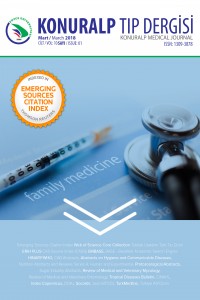Abstract
Amaç: Bir palyatif bakım merkezinde yatan hastaların klinik özelliklerini
incelemek ve uzun yatış süresi, hastaneden taburculuk durumu ile ilişkili
faktörleri araştırmaktır.
Gereç ve Yöntem: Kesitsel ve retrospektif bir çalışmadır. Palyatif bakım merkezinde
1 Ağustos 2015 – 30 Temmuz 2017 tarihleri arasında yatan hastaların dosyaları
incelendi. Tüm hastaların demografik özellikleri, komorbid durumları, ilaç
sayıları, yatış şikayetleri, ilk yatışındaki nutrisyon, bası yarası ve ağrı
durumları değerlendirildi. Hastaların uzun yatış süresi (≥ 15 gün) ve
taburculuk durumları (eve taburcu, ileri yoğun bakım merkezine sevk ve eks) ile
ilişkili faktörler için değişkenler Spearman’s correlation test ile analiz
edildi.
Bulgular: Çalışmaya uygun alınan 319 hastanın (kadın, %45) ortalama yaşı
71±15,8 ve ortalama yatış süresi 15,4±15,7 gündü. En sık üç komorbid hastalık
malnütrisyon %59, malignite %44, enfeksiyon hastalığı %33 idi. En sık yatış
şikayetleri oral alım bozukluğu %35, genel durum bozukluğu %19, ateş %17 idi.
Uzun yatış süresi ile ilişkili pozitif faktörler ileri evre bası
yarası (r=0,366; p<0,001), serebrovasküler hastalık (r=0,175; p=0,002), hipertansiyon
(r=0,158; p=0,005) ve diabetes mellitusdur (r=0,129; p=0,021). Taburculuk
durumu (ileri yoğun bakıma sevk ve/veya eks durumu) ile ilişkili pozitif
faktörler ise, malignite (r=0,234; p<0,001), opioid kullanımı (r=0,204;
p<0,001), parenteral beslenme tipi (r=0,20; p<0,001) ve halsizlik-yorgunluk
semptomudur (r=0,115; p=0,041).
Sonuç: İleri evre bası yarası hastanede yatış süresini uzatan en önemli
faktördür. Hastaların taburculuk durumu için en etkili faktörler ise malignite,
opioid kullanımı, parenteral beslenme tipi ve halsizlik-yorgunluk semptomunun
varlığıdır.
References
- Referans1: Dr Umut Safer, Sağlık Bilimleri Üniversitesi, Sultan Abdülhamit Han Eğitim ve Araştırma Hastanesi, İç Hastalıkları Anabilim Dalı, Palyatif Bakım Merkezi, İstanbul, Türkiye, mail adresi: umutsafer@gmail.com
- Referans2: Dr Zeynel Abidin Öztürk, Gaziantep Tıp Fakültesi, İç Hastalıkları Anabilim Dalı, Geriatri Bilim Dalı, Gaziantep, Türkiye, mail adresi: zaodr@yahoo.com.tr
Abstract
Objective: Our aim is to examine the clinical characteristics of
patients in a palliative care center and to investigate the factors associated
with long-term hospitalization and hospital discharge status.
Materials and Methods: A cross-sectional-retrospective study.
The files of inpatients were examined between August 1, 2015 and July 30, 2017
in a palliative care center. Demographic characteristics, comorbid conditions,
numbers of medication, complaints of hospitalization, nutritional, pressure sore,
and pain status at first hospitalization were evaluated in all patients.
Variables were analyzed using Spearman's correlation test for factors
associated with long-term hospitalization (≥15 days) and discharge status (go
home, referred to advance intensive care unit, and ex).
Results: The mean age of 319 eligible patients (females, 45%)
was 71±15.8 and mean duration of hospitalization was 15.4±15.7 days. The most
common comorbid diseases were malnutrition (59%), malignancy (44%), and
infectious disease (33%). The most frequent admission complaints were oral
intake impairment (35%), general condition impairment (15%), and fever (17%).
Positive factors associated with
long-term hospitalization were advanced stage pressure sore (r=0,366;
p<0,001), cerebrovascular disease (r=0,175; p=0,002), hypertension (r=0,158;
p=0,005), and diabetes mellitus (r=0,129; p=0,021). Positive factors related to
discharge status (referred to intensive care unit and/or ex) were malignancy (r=0,234;
p<0,001), using opioid (r=0,204; p<0,001), parenteral nutrition (r=0, 20;
p<0.001) and weakness-fatigue symptoms (r=0.115, p=0.041).
Conclusion: Advanced stage pressure sore are the most important
factor that prolongs the length of hospital stay. The most effective factors
for patients with discharge status are malignancy, using opioid, parenteral
nutrition and the symptoms of weakness-fatigue.
References
- Referans1: Dr Umut Safer, Sağlık Bilimleri Üniversitesi, Sultan Abdülhamit Han Eğitim ve Araştırma Hastanesi, İç Hastalıkları Anabilim Dalı, Palyatif Bakım Merkezi, İstanbul, Türkiye, mail adresi: umutsafer@gmail.com
- Referans2: Dr Zeynel Abidin Öztürk, Gaziantep Tıp Fakültesi, İç Hastalıkları Anabilim Dalı, Geriatri Bilim Dalı, Gaziantep, Türkiye, mail adresi: zaodr@yahoo.com.tr
Details
| Primary Language | Turkish |
|---|---|
| Subjects | Health Care Administration |
| Journal Section | Articles |
| Authors | |
| Publication Date | March 28, 2018 |
| Acceptance Date | December 29, 2017 |
| Published in Issue | Year 2018 Volume: 10 Issue: 1 |


